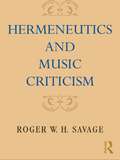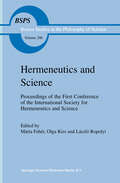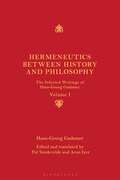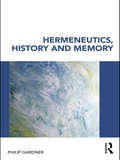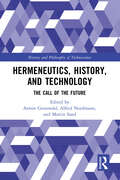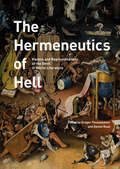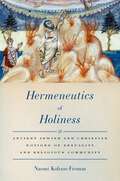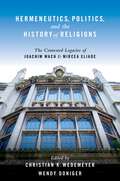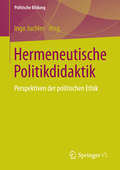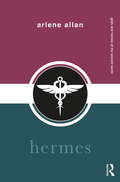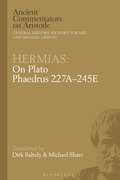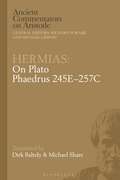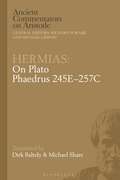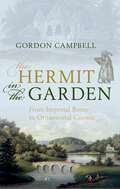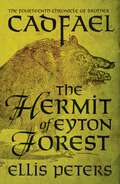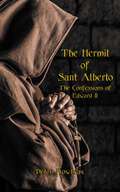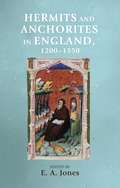- Table View
- List View
Hermeneutics and Music Criticism
by Roger W. SavageHermeneutics and Music Criticism forges new perspectives on aesthetics, politics and contemporary interpretive strategies. By advancing new insights into the roles judgment and imagination play both in our experiences of music and its critical interpretation, this book reevaluates our current understandings of music’s transformative power. The engagement with critical musicologists and philosophers, including Adorno, Gadamer, and Ricoeur, provides a nuanced analysis of the crucial issues affecting the theory and practice of music criticism. By challenging musical hermeneutics’ deployment as a means of deciphering social values and meanings, Hermeneutics and Music Criticism offers an answer to the long-standing question of how music’s expression of moods and feelings affects us and our relation to the world.
Hermeneutics and Music Criticism
by Roger W. SavageHermeneutics and Music Criticism forges new perspectives on aesthetics, politics and contemporary interpretive strategies. By advancing new insights into the roles judgment and imagination play both in our experiences of music and its critical interpretation, this book reevaluates our current understandings of music’s transformative power. The engagement with critical musicologists and philosophers, including Adorno, Gadamer, and Ricoeur, provides a nuanced analysis of the crucial issues affecting the theory and practice of music criticism. By challenging musical hermeneutics’ deployment as a means of deciphering social values and meanings, Hermeneutics and Music Criticism offers an answer to the long-standing question of how music’s expression of moods and feelings affects us and our relation to the world.
Hermeneutics and Science (Boston Studies in the Philosophy and History of Science #206)
by Márta Fehér, Olga Kiss and László RopolyiHermeneutics was elaborated as a specific art of understanding in humanities. The discovered paradigmatic, historical characteristics of scientific knowledge, and the role of rhetoric, interpretation and contextuality enabled us to use similar arguments in natural sciences too. In this way a new research field, the hermeneutics of science emerged based upon the works of Husserl, Merleau-Ponty, Heidegger and Gadamer. A dialogue between philosophers and scientists begins in this volume on hermeneutic approaches to physics, biology, ethology, mathematics and cognitive science. Scientific principles, methodologies, discourse, language, and metaphors are analyzed, as well as the role of the lay public and the legitimation of science. Different hermeneutical-phenomenological approaches to perception, experiments, methods, discovery and justification and the genesis of science are presented. Hermeneutics shed a new light on the incommensurability of paradigms, the possibility of translation and the historical understanding of science.
Hermeneutics between History and Philosophy: The Selected Writings of Hans-Georg Gadamer
by Hans-Georg Gadamer Pol Vandevelde Arun IyerHermeneutics between History and Philosophy collects together Gadamer's remaining important untranslated writings on the problem of history and the major philosophical traditions of the 20th century from the standpoint of hermeneutics. In these writings, Gadamer examines important thinkers as Husserl, Heidegger, Sartre, Bourdieu and Habermas and their ongoing legacies. This volume also includes a preface by the editors, who are also the translators, presenting the structure of the volume, a substantial introductionsituating Gadamer's particular project and examining the place of hermeneutics vis-a-vis the disciplines of history and philosophy in the 20th century. The translation is followed by a glossary of German terms and Greek and Latin expressions, as well as a bibliography of all the works cited and alluded to by Gadamer.
Hermeneutics between History and Philosophy: The Selected Writings of Hans-Georg Gadamer
by Arun Iyer Pol Vandevelde Hans-Georg GadamerHermeneutics between History and Philosophy collects together Gadamer's remaining important untranslated writings on the problem of history and the major philosophical traditions of the 20th century from the standpoint of hermeneutics. In these writings, Gadamer examines important thinkers as Husserl, Heidegger, Sartre, Bourdieu and Habermas and their ongoing legacies. This volume also includes a preface by the editors, who are also the translators, presenting the structure of the volume, a substantial introductionsituating Gadamer's particular project and examining the place of hermeneutics vis-a-vis the disciplines of history and philosophy in the 20th century. The translation is followed by a glossary of German terms and Greek and Latin expressions, as well as a bibliography of all the works cited and alluded to by Gadamer.
Hermeneutics, History and Memory
by Philip GardnerHistory is the true record of an absent past. The trust between historians and their readers has always been founded upon this traditional claim. In a postmodern world, that claim and that trust have both been challenged as never before, drawing either angry or apologetic responses from historians. Hermeneutics, History and Memory answers differently. It sees the sceptical challenge as an opportunity for reflection on history’s key processes and practices, and draws upon methodological resources that are truly history’s own, but from which it has become estranged. In seeking to restore these resources, to return history to its roots, this book presents a novel contribution to topical academic debate, focusing principally upon: the challenges and detours of historical methodology hermeneutic interpretation in history the work of Paul Ricoeur the relation between history and memory. Hermeneutics, History and Memory will appeal to experienced historical researchers who seek to explore the theoretical and methodological foundations of their empirical investigations. It will also be highly beneficial to research students in history and the social sciences concerned with understanding the principles and practices through which documentary analysis and in-depth interview can be both validated and conducted.
Hermeneutics, History and Memory
by Philip GardnerHistory is the true record of an absent past. The trust between historians and their readers has always been founded upon this traditional claim. In a postmodern world, that claim and that trust have both been challenged as never before, drawing either angry or apologetic responses from historians. Hermeneutics, History and Memory answers differently. It sees the sceptical challenge as an opportunity for reflection on history’s key processes and practices, and draws upon methodological resources that are truly history’s own, but from which it has become estranged. In seeking to restore these resources, to return history to its roots, this book presents a novel contribution to topical academic debate, focusing principally upon: the challenges and detours of historical methodology hermeneutic interpretation in history the work of Paul Ricoeur the relation between history and memory. Hermeneutics, History and Memory will appeal to experienced historical researchers who seek to explore the theoretical and methodological foundations of their empirical investigations. It will also be highly beneficial to research students in history and the social sciences concerned with understanding the principles and practices through which documentary analysis and in-depth interview can be both validated and conducted.
Hermeneutics, History, and Technology: The Call of the Future (History and Philosophy of Technoscience)
by Armin Grunwald Alfred Nordmann Martin SandFor better and worse, the future is often conceived in technological terms. Technology is supposed to meet the challenge of climate change or resource depletion. And when one asks about the world in 20 or 100 years, answers typically revolve around AI, genome editing, or geoengineering. There is great demand to speculate about the future of work, the future of mobility, Industry 4.0, and Humanity 2.0. The humanities and social sciences, science studies, and technology assessment respond to this demand but need to seek out a responsible way of taking the future into account. This collection of papers, interviews, debates grew out of disagreements about technological futures, speculative ethics, plausible scenarios, anticipatory governance, and proactionary and precautionary approaches. It proposes Hermeneutic Technology Assessment as a way of understanding ourselves through our ways of envisioning the future. At the same time, a hermeneutic understanding of technological projects and prototypes allows for normative assessments of their promises. Is the future an object of design? This question can bring together and divide policy makers, STS scholars, social theorists, and philosophers of history, and it will interest also the scientists and engineers who labor under the demand to deliver that future.
Hermeneutics, History, and Technology: The Call of the Future (History and Philosophy of Technoscience)
For better and worse, the future is often conceived in technological terms. Technology is supposed to meet the challenge of climate change or resource depletion. And when one asks about the world in 20 or 100 years, answers typically revolve around AI, genome editing, or geoengineering. There is great demand to speculate about the future of work, the future of mobility, Industry 4.0, and Humanity 2.0. The humanities and social sciences, science studies, and technology assessment respond to this demand but need to seek out a responsible way of taking the future into account. This collection of papers, interviews, debates grew out of disagreements about technological futures, speculative ethics, plausible scenarios, anticipatory governance, and proactionary and precautionary approaches. It proposes Hermeneutic Technology Assessment as a way of understanding ourselves through our ways of envisioning the future. At the same time, a hermeneutic understanding of technological projects and prototypes allows for normative assessments of their promises. Is the future an object of design? This question can bring together and divide policy makers, STS scholars, social theorists, and philosophers of history, and it will interest also the scientists and engineers who labor under the demand to deliver that future.
The Hermeneutics of Hell: Visions and Representations of the Devil in World Literature
by Gregor Thuswaldner and Daniel RussThis collection of essays analyzes global depictions of the devil from theological, Biblical, and literary perspectives, spanning the late Middle Ages to the 21st century. The chapters explore demonic representations in the literary works of Johann Wolfgang von Goethe, Fyodor Dostoyevsky, Dante Alighieri, Charles Baudelaire, John Milton, H.P. Lovecraft, and Cormac McCarthy, among others. The text examines other media such as the operas Orfeo and Erminia sul Giordano and the television shows Breaking Bad, The Sopranos, and Mad Men. The Hermeneutics of Hell, featuring an international set of established and up-and-coming authors, masterfully examines the evolution of the devil from the Biblical accounts of the Middle Ages to the individualized presence of the modern world.
Hermeneutics of Holiness: Ancient Jewish and Christian Notions of Sexuality and Religious Community
by Naomi Koltun-FrommIn Hermeneutics of Holiness , Naomi Koltun-Fromm examines the ancient nexus of holiness and sexuality and explores its roots in the biblical texts as well as its manifestations throughout ancient and late-ancient Judaism and early Syriac Christianity. In the process, she tells the story of how the biblical notions of "holy person" and "holy community" came to be defined by the sexual and marriage practices of various interpretive communities in late antiquity. Koltun-Fromm seeks to explain why sexuality, especially sexual restraint, became a primary demarcation of sacred community boundaries among Jews and Christians in fourth-century Persian-Mesopotamia. She charts three primary manifestations of holiness: holiness ascribed, holiness achieved, and holiness acquired through ritual purity. Hermeneutics of Holiness traces the development of these three concepts, from their origin in the biblical texts to the Second Temple literature (both Jewish and Christian) to the Syriac Christian and rabbinic literature of the fourth century. In so doing, this book establishes the importance of biblical interpretation for late ancient Jewish and Christian practices, the centrality of holiness as a category for self-definition, and the relationship of fourth-century asceticism to biblical texts and interpretive history.
Hermeneutics of Holiness: Ancient Jewish and Christian Notions of Sexuality and Religious Community
by Naomi Koltun-FrommIn Hermeneutics of Holiness , Naomi Koltun-Fromm examines the ancient nexus of holiness and sexuality and explores its roots in the biblical texts as well as its manifestations throughout ancient and late-ancient Judaism and early Syriac Christianity. In the process, she tells the story of how the biblical notions of "holy person" and "holy community" came to be defined by the sexual and marriage practices of various interpretive communities in late antiquity. Koltun-Fromm seeks to explain why sexuality, especially sexual restraint, became a primary demarcation of sacred community boundaries among Jews and Christians in fourth-century Persian-Mesopotamia. She charts three primary manifestations of holiness: holiness ascribed, holiness achieved, and holiness acquired through ritual purity. Hermeneutics of Holiness traces the development of these three concepts, from their origin in the biblical texts to the Second Temple literature (both Jewish and Christian) to the Syriac Christian and rabbinic literature of the fourth century. In so doing, this book establishes the importance of biblical interpretation for late ancient Jewish and Christian practices, the centrality of holiness as a category for self-definition, and the relationship of fourth-century asceticism to biblical texts and interpretive history.
Hermeneutics, Politics, and the History of Religions: The Contested Legacies of Joachim Wach and Mircea Eliade
by Wendy Doniger Christian WedemeyerThis volume comprises papers presented at a conference marking the 50th anniversary of Joachim Wach's death, and the centennial of Mircea Eliade's birth. Its purpose is to reconsider both the problematic, separate legacies of these two major twentieth-century historians of religions, and the bearing of these two legacies upon each other. Shortly after Wach's death in 1955, Eliade succeeded him as the premiere historian of religions at the University of Chicago. As a result, the two have been associated with each other in many people's minds as the successive leaders of the so-called "Chicago School" in the history of religions. In fact, as this volume makes clear, there never was a monolithic Chicago School. Although Wach reportedly referred to Eliade as the most astute historian of religions of the day; the two never met, and their approaches to the study of religions differed significantly. Several dominant issues run through the essays collected here: the relationship between the two men's writings and their lives, and in Eliade's case, the relationship between his political commitments and his writings in fiction, history of religions, and autobiography. Both men's contributions to the field continue to provoke controversy and debate, and this volume sheds new light on these controversies and what they reveal about these two `scholars' legacies.
Hermeneutics, Politics, and the History of Religions: The Contested Legacies of Joachim Wach and Mircea Eliade
by Christian Wedemeyer Wendy DonigerThis volume comprises papers presented at a conference marking the 50th anniversary of Joachim Wach's death, and the centennial of Mircea Eliade's birth. Its purpose is to reconsider both the problematic, separate legacies of these two major twentieth-century historians of religions, and the bearing of these two legacies upon each other. Shortly after Wach's death in 1955, Eliade succeeded him as the premiere historian of religions at the University of Chicago. As a result, the two have been associated with each other in many people's minds as the successive leaders of the so-called "Chicago School" in the history of religions. In fact, as this volume makes clear, there never was a monolithic Chicago School. Although Wach reportedly referred to Eliade as the most astute historian of religions of the day; the two never met, and their approaches to the study of religions differed significantly. Several dominant issues run through the essays collected here: the relationship between the two men's writings and their lives, and in Eliade's case, the relationship between his political commitments and his writings in fiction, history of religions, and autobiography. Both men's contributions to the field continue to provoke controversy and debate, and this volume sheds new light on these controversies and what they reveal about these two `scholars' legacies.
Hermeneutische Politikdidaktik: Perspektiven der politischen Ethik (Politische Bildung)
by Ingo JuchlerDie hermeneutische Politikdidaktik setzt sich mit Fragen nach den Möglichkeiten einer auf das Verstehen des Politischen ausgerichteten politischen Bildung auseinander. Hierbei sind ethische Aspekte von besonderer Relevanz. Der Band wirft ein Schlaglicht auf wirtschaftsethische, medienethische, institutionenethische und handlungsethische Dimensionen der politischen Bildung unter der Perspektive, wie diese zum Verstehen des Politischen und zur politischen Urteilsbildung beitragen können.
Hermes (Gods and Heroes of the Ancient World)
by Arlene AllanHermes redresses the gap in modern English scholarship on this fascinating and complex god, presenting its readers with an introduction to Hermes’ social, religious and political importance through discussions of his myths, iconography and worship. It also brings together in one place an integrated survey of his reception and interpretation in contemporaneous neighbouring cultures in antiquity as well as discussion of his reception in the post-classical periods up to the present day. This volume is an invaluable resource for anyone wanting to explore the many facets of Hermes’ myth, worship and reception.
Hermes (Gods and Heroes of the Ancient World)
by Arlene AllanHermes redresses the gap in modern English scholarship on this fascinating and complex god, presenting its readers with an introduction to Hermes’ social, religious and political importance through discussions of his myths, iconography and worship. It also brings together in one place an integrated survey of his reception and interpretation in contemporaneous neighbouring cultures in antiquity as well as discussion of his reception in the post-classical periods up to the present day. This volume is an invaluable resource for anyone wanting to explore the many facets of Hermes’ myth, worship and reception.
Hermias: On Plato Phaedrus 227A–245E (Ancient Commentators on Aristotle)
by Michael Share Dirk BaltzlyThis commentary records, through notes taken by Hermias, Syrianus' seminar on Plato's Phaedrus, one of the world's most influential celebrations of erotic beauty and love. It is the only Neoplatonic commentary on Plato's Phaedrus to have survived in its entirety. Further interest comes from the recorded interventions by Syrianus' pupils - including those by Proclus, his eventual successor as head of the Athenian school, who went on to teach Hermias' father, Ammonius. The first of two volumes of Hermias' commentary, the chapters translated here discuss the argument that the soul can be proved immortal as being the self-moving source of eternal motion. Aristotle explicitly disagreed with Plato on this treatment of the soul and Syrianus, having previously (in a commentary on the Metaphysics) criticised Aristotle severely when he disagreed with Plato, feels obliged here, too, to address the apparent disagreement. This new translation is thus vital for understanding Syrianus' attitude to Aristotle.
Hermias: On Plato Phaedrus 227A–245E (Ancient Commentators on Aristotle)
by Michael Share Dirk BaltzlyThis commentary records, through notes taken by Hermias, Syrianus' seminar on Plato's Phaedrus, one of the world's most influential celebrations of erotic beauty and love. It is the only Neoplatonic commentary on Plato's Phaedrus to have survived in its entirety. Further interest comes from the recorded interventions by Syrianus' pupils - including those by Proclus, his eventual successor as head of the Athenian school, who went on to teach Hermias' father, Ammonius. The first of two volumes of Hermias' commentary, the chapters translated here discuss the argument that the soul can be proved immortal as being the self-moving source of eternal motion. Aristotle explicitly disagreed with Plato on this treatment of the soul and Syrianus, having previously (in a commentary on the Metaphysics) criticised Aristotle severely when he disagreed with Plato, feels obliged here, too, to address the apparent disagreement. This new translation is thus vital for understanding Syrianus' attitude to Aristotle.
Hermias: On Plato Phaedrus 245E–257C (Ancient Commentators on Aristotle)
by Michael Share Dirk BaltzlyThis commentary records, through notes taken by Hermias, Syrianus' seminar on Plato's Phaedrus, one of the world's most influential celebrations of erotic beauty and love. It is the only Neoplatonic commentary on Plato's Phaedrus to have survived in its entirety. Further interest comes from the recorded interventions by Syrianus' pupils - including those by Proclus, his eventual successor as head of the Athenian school, who went on to teach Hermias' father, Ammonius. The second of two volumes of Hermias' commentary, the chapters translated here begin with a discussion of how the discarnate soul is visualised as a winged chariot team whose charioteer may gain some glimpse of beauty itself, which can explain subsequent erotic longing. This volume provides a translation is accompanied by explanatory notes, an introduction detailing the significance and context of the treatise and a scholarly apparatus including multiple indexes, glossaries and a bibliography.
Hermias: On Plato Phaedrus 245E–257C (Ancient Commentators on Aristotle)
by Michael Share Dirk BaltzlyThis commentary records, through notes taken by Hermias, Syrianus' seminar on Plato's Phaedrus, one of the world's most influential celebrations of erotic beauty and love. It is the only Neoplatonic commentary on Plato's Phaedrus to have survived in its entirety. Further interest comes from the recorded interventions by Syrianus' pupils - including those by Proclus, his eventual successor as head of the Athenian school, who went on to teach Hermias' father, Ammonius. The second of two volumes of Hermias' commentary, the chapters translated here begin with a discussion of how the discarnate soul is visualised as a winged chariot team whose charioteer may gain some glimpse of beauty itself, which can explain subsequent erotic longing. This volume provides a translation is accompanied by explanatory notes, an introduction detailing the significance and context of the treatise and a scholarly apparatus including multiple indexes, glossaries and a bibliography.
The Hermit in the Garden: From Imperial Rome to Ornamental Gnome
by Gordon CampbellTracing its distant origins to the villa of the Roman emperor Hadrian in the second century AD, the eccentric phenomenon of the ornamental hermit enjoyed its heyday in the England of the eighteenth century It was at this time that it became highly fashionable for owners of country estates to commission architectural follies for their landscape gardens. These follies often included hermitages, many of which still survive, often in a ruined state. Landowners peopled their hermitages either with imaginary hermits or with real hermits - in some cases the landowner even became his own hermit. Those who took employment as garden hermits were typically required to refrain from cutting their hair or washing, and some were dressed as druids. Unlike the hermits of the Middle Ages, these were wholly secular hermits, products of the eighteenth century fondness for 'pleasing melancholy'. Although the fashion for them had fizzled out by the end of the eighteenth century, they had left their indelible mark on both the literature as well as the gardens of the period. And, as Gordon Campbell shows, they live on in the art, literature, and drama of our own day - as well as in the figure of the modern-day garden gnome. This engaging and generously illustrated book takes the reader on a journey that is at once illuminating and whimsical, both through the history of the ornamental hermit and also around the sites of many of the surviving hermitages themselves, which remain scattered throughout England, Scotland, and Ireland. And for the real enthusiast, there is even a comprehensive checklist, enabling avid hermitage-hunters to locate their prey.
The Hermit Of Eyton Forest (The Cadfael Chronicles #14)
by Ellis PetersIn the Autumn of 1142, a holy man living as a hermit is found dead. His murder coincides with the arrival at the Abbey of Shrewsbury of the new Lord of Eaton. Brother Cadfael suspects a connection, but the new lord is only ten years old – who can have been acting in his interests?
The Hermit of Sant Alberto: The Confessions of Edward II
by Peter MowbrayEngland 1327, and after a daring raid, a prisoner is liberated from the imposing Berkeley Castle. Italy, 1334, and at the remote monastery of Sant Alberto, an eminent envoy of Pope John XXII has arrived to speak with a hermit that dwells within the small community. Who then is the hermit, and why would he be of interest to the pope? When the hermit is confronted with the ghosts of a long distant past, together with the envoy and a kindly monk, he relives again a past full of love, triumph, distrust and hate. A life of privilege and a rich ancestry that offered so much would eventually lead to ruin and disgrace. A legacy that would be doomed to failure. His love for two men would bring about the downfall of this man so desperately unsuited to the life of nobility and power to which he was born. Past memories are revealed and days of both triumph and despair are relived as the hermit confronts a former life, laid buried for so long. Can this tortured soul finally find redemption in the confession of grave sins from the past? Victories and defeats, love and death all play a part in the story of a man whom history has designated a foolish ineffectual character. A man whose fall from grace had led him from the glories of the English royal court to a dusty sun-drenched monastery in Lombardy where he had hoped to forget.
Hermits and anchorites in England, 1200–1550 (Manchester Medieval Sources)
by E. A. JonesThis source book offers a comprehensive treatment of solitary religious lives in England in the late Middle Ages. It covers both enclosed recluses (anchorites) and free-wandering hermits, and explores the relationship between them. Although there has been a recent surge of interest in the solitary vocations, especially anchorites, this has focused almost exclusively on a small number of examples. The field is in need of reinvigoration, and this book provides it. Featuring translated extracts from a wide range of Latin, Middle English and Old French sources, as well as a scholarly introduction and commentary from one of the foremost experts in the field, Hermits and anchorites in England is an invaluable resource for students and lecturers alike.
